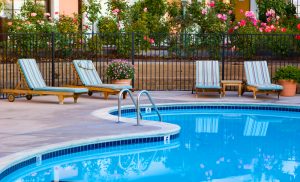Swimming pools are a great asset in summer, and their inclusion in your home’s backyard will undoubtedly increase the value of the property. But swimming pools come with inherent risks that must never be ignored. Luckily, these risks can be reduced with pool fences by Natural Enclosures Fence Company.
 While there are national building codes and local regulations relating to pool safety in the US, even when fencing is mandatory, many people allow direct access to the pool from the house and play areas. This produces unnecessary risks for toddlers and young children, especially those aged one to four – a demographic identified by the Centers for Disease Control (CDC) as being most at risk of drowning. Additionally, the CDC has found that “unintentional drowning” is the fifth highest cause of unintentional injury death in the US. It is also the second leading cause of child deaths and accounts for nearly a third of the total child deaths caused by unintentional injury.
While there are national building codes and local regulations relating to pool safety in the US, even when fencing is mandatory, many people allow direct access to the pool from the house and play areas. This produces unnecessary risks for toddlers and young children, especially those aged one to four – a demographic identified by the Centers for Disease Control (CDC) as being most at risk of drowning. Additionally, the CDC has found that “unintentional drowning” is the fifth highest cause of unintentional injury death in the US. It is also the second leading cause of child deaths and accounts for nearly a third of the total child deaths caused by unintentional injury.
Those are horrifying statistics, but they don’t have to put you off building a pool. In fact, all you need is well-designed pool fencing!
Get Custom Pool Fencing by Natural Enclosures
The CDC suggests all homeowners with backyard swimming pools fence them on all four sides so they cannot be accessed from anywhere, except through a gate that is self-latching and self-closing. This makes perfect sense, and it is, in any case, a common legal requirement throughout Georgia. That said, it is important to check exactly what your municipality or local authority requires, not only in terms of fencing but in terms of construction and siting of pools too. There are often minor differences.
National and International Building Code for Pool Fencing
The International Code Council (ICC) is a non-profit organization that has published codes and building standards since 1994. While not mandatory, many of their standards are adopted as law throughout the US.
Prior to the ICC, from about 1950 until 1994 the international Building Officials and Code Administrators (BOCA) published building codes and standards, and they were the originator of the US BOCA Pool Fence Code. The Southern Building Code Congress International (SBCCI) also designed codes that were designed for use by state and local governments. Based in Alabama, they published a standard swimming pool code that included “enclosure” of pools.
Both BOCA and the SBCCI were incorporated into the ICC so there would be one set of building standards for local governments and authorities to use for reference, and as a base for their legislation. This is published by the ICC as an International Building Code (IBC) that includes all forms of acceptable pool fencing and other barriers that may be built around pools.
The ultimate aim of the IBC is to prevent the likelihood of injury and drowning in swimming pools.
Minimum Requirements for Pool Fencing in Georgia
Generally, in Georgia swimming pool plans and permits are required for all commercial and residential projects. These must comply with minimum barrier height and clearance requirements as well as clearances for barriers around any proposed swimming pool. Dimensions, spacing, and barrier, as well as gate height must all be indicated on plans.
All swimming pools must be fenced in, but homeowners are allowed to use one side of the house as part of the overall barrier. Regulations generally state that if the house is included as part of the barrier, there must be an alarm on any door that leads to the pool area for security reasons. Any other gates must open away from the pool.
A major safety factor is to ensure that children cannot squeeze through or under any parts of swimming pool fencing. Based on the IBC, fences must be at least four foot high and no more than four inches off the ground. Any vertical slats must be no more than four inches apart. Chain-link fencing can be used, but the openings may not be any bigger than 1.75 inches in diameter.
It is vital that there are no parts of a pool fence that can be used as a ladder, to support feet or enable anyone to pull himself up and over the fence.
Gates have to be self-closing and installed with latches that are at least four foot above the ground. Any minimum height fencing requires latches that are installed no more than six inches from the top of the fence so that children cannot reach through and open it.
At Natural Enclosures we understand the importance of pool fencing regulations as well as the value of good-looking fencing. If you have a pool, call us to discuss the best options that will enable you to meet your legal obligations and increase the value of your property.
